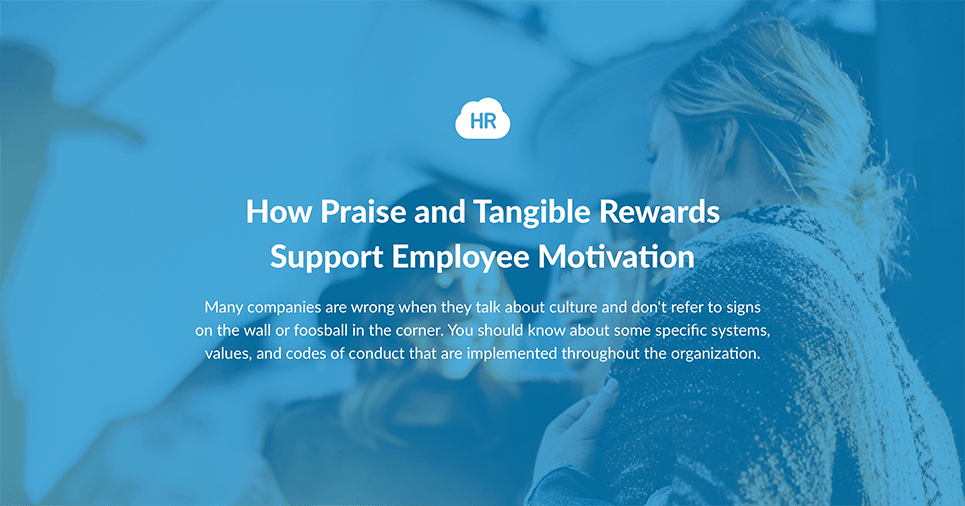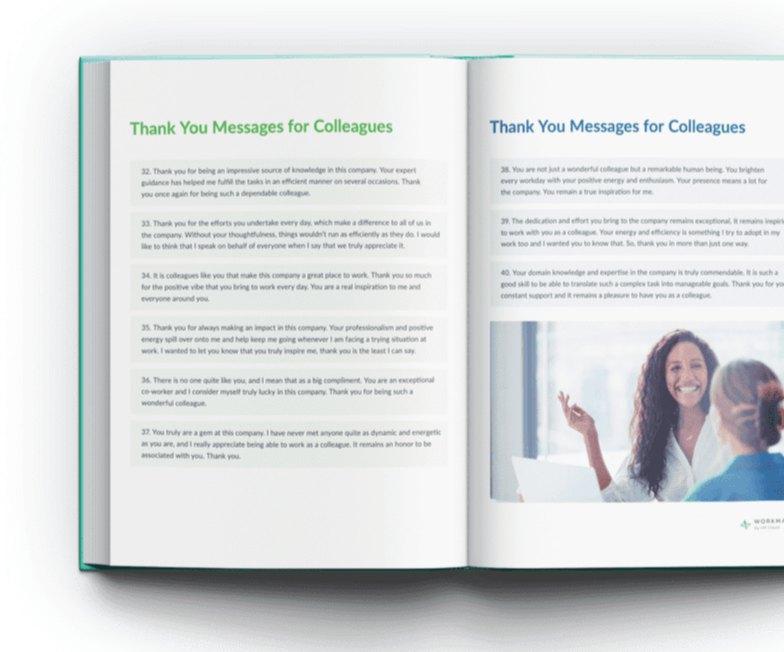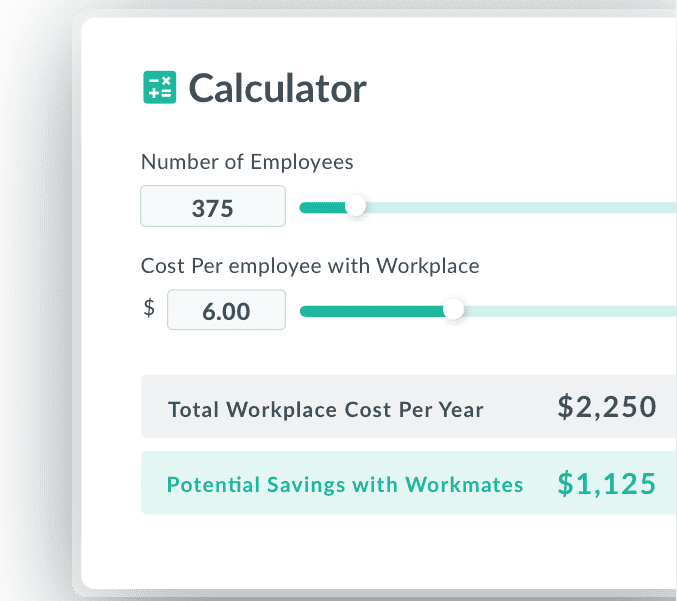How Praise and Tangible Rewards Support Employee Motivation

An efficient and motivated team of employees is the dream of every business leader. There are not many attributes of a strong team that contribute to the company’s success, but the challenge of building a good team requires smooth recruitment and strong management.
This article discusses the difference between extrinsic and intrinsic motivation, the role of material rewards, and other strategies for using employee enthusiasm.
Employee engagement is a password that companies in all industries have found difficult to crack. Research shows that more commitment and retention can significantly increase production and save the bottom line.
For people currently working in the company or recruiting top talent, the company needs to understand how their workplace culture supports and empowers employees.
Many companies are wrong when they talk about culture and don't refer to signs on the wall or foosball in the corner. You should know about some specific systems, values, and codes of conduct that are implemented throughout the organization.
The 40 Best Thank You
Messages for Colleagues
building a positive and engaged culture at your company.

Why Building a Culture for Employee Appreciation
People are the core and soul of any organization, and the first task should be to ensure that you have all the tools you need to succeed. One tool that many managers don't use often is praise. Praise is a key factor on the road to empowerment, but this does not happen often.
According to a Gallup survey, employees who are not properly recognized at work were three times more likely to leave next year in comparison to other employees. For many executives, this statistic is surprising as well as self-realization.
Senior managers often worry about shareholder performance and dividends, rather than investing their energy in workplace cultural initiatives. To effectively promote a culture of authorization and invention, you need a system of active work that recognizes and comprehends the efforts and accomplishments of employees.
These systems come in many different structures and perspectives, so figuring out what is useful for your business can be a challenge initially. It is important to have multiple plans, not only to cover people from all corners of the organization but also to show that senior management also values these plans.
Various Forms of External Motivators: Cash Incentives and Tangible Rewards
External motivators are generally used by various employers or senior managers and only two of the types are recognized the most in any organization: tangible rewards and cash incentives. You must also be sure that employees get more motivated by rewards. Given the recent survey report, the tangible rewards are a wholesome package for boosting any employee's motivation.
To be more precise, tangible rewards are credits or coupons distributed by employers that can be reclaimed in exchange for any merchandise, ordeals, or other commodities. The employer must determine what his award catalog includes: different jewelry items like silver necklaces or tennis bracelets, sports kit, gift cards, concert tickets, electronic derivatives, charitable donations, personalized company products, and many such huge possibilities.
Given below are three main aspects that make tangible rewards more motivating:
-
Tangible Rewards are segregated from Salary
The first point is pretty simple: employees expect to get a certain amount of money for their work. When employers think of offering more money, employees will consider them as bonuses and salaries. This does not mean that employees do not pay attention to the monetary reward system, but that tangible rewards have a greater impact.
It is popularly known as a shared mindset, not an independent mindset. Although people usually have a difference between monetary compensation and standard employee benefits. Monetary incentives are quickly seen as an extension of standard employee benefits and therefore less interesting.
-
Tangible Rewards are inclined more towards wants than needs
The second point naturally comes from the first point: Although monetary incentives usually include pragmatic purchases (such as employee salaries), material incentives are often condescending. Spend some money, you are worth it.
Unexpectedly, employees are more likely to review the homemade espresso machines they bought with bonus points, rather than the electricity bills they paid with cash bonuses. A stronger emotional impact, which makes them more motivated.
-
Tangible Rewards are Unpredictable
The third and final explanation of why material rewards and recognition are so motivating. Although cash rewards are usually promised, cash rewards are usually delivered as soon as the recipient has done something commendable.
To test this theory, an experiment was conducted in which some participants received unexpected material rewards, while others received planned cash rewards. Those who found themselves in an unexpected state showed considerably higher goal achievement than their peers.
Variable rewards provide better and more consistent performance than scheduled rewards. In other words, people who receive a reward every ten minutes and are busy completing tasks do not perform better than a person who received a reward every seven to twelve minutes, with barely different time intervals between each reward. The surprising aspect of rewards appears to be the key to nurturing motivation.
The Capability of Praise: Unlocking Intrinsic Motivation
External motivational factors are undoubtedly important in work, but the best people are those who also pursue excellence internally, that is, those with strong internal motivation.
High intrinsic motivation is associated with many positive outcomes, including increased endurance, productivity, creativity, and better problem-solving. As mentioned earlier, intrinsic motivation is about meeting the intrinsic needs of employees.
Self-expression, social relationships, skills, and the list goes on. Although material rewards alone are unlikely to benefit from these innate desires, they are more likely to stimulate motivation if accompanied by praise and encouragement to employees.
You already know that material rewards have a greater impact than monetary rewards. Therefore, it is easy to reward your employees with points, and they can exchange points for items and experience (instead of cash).
Their decisions will make them happier and more externally motivated, that is, encourage employees to perform well in the future in order to obtain greater returns.
However, in this work environment, what you may not experience is a kind of inner satisfaction. Yes, it is good to receive a gift, but it has nothing to do with inner motivation.
Now imagine that you not only reward an employee with points, but also take the time to write a note describing in detail your appreciation for him and his work: attention, creativity, and the employee's tireless dedication to getting the job finished.
When you combine material rewards with words of appreciation, it suddenly means more. Employees have now received not only physical recognition for their work but also personal praise. It satisfies internal needs, such as a desire to feel capable, concerned, and valued, so praise can turn external motivational factors into internal motivational factors.
When both internal and external motivation is maintained at work, employees will have everything they need to achieve their maximum potential. Tangible rewards plus words of praise are a unique and effective way to support these two motivations, and leaders who want to see the team succeed will do so. Praise and encouragement are welcome as a routine practice.
Parallel Between Tangible Rewards and Praises
Given the psychology behind tangible rewards and motivations, it is easy to advocate a structured employee reward plan. They not only improve the quality of employee services, making the work more satisfying and rewarding, but they also benefit the company by helping to increase employee productivity in various fields.
Whether you want to support your employees through an internal compensation plan or a simplified third-party solution, executives must consider the importance of motivation, because it helps employees work and the company develop.
Conclusion
Creating a positive workplace culture requires more effort than you can imagine. The systems and procedures required to develop culture must not only be universal and inclusive but must also conform to the values and norms of the people who make up the organization. Cultural fit is the key. When the parts of the puzzle are put together, it creates an environment with more opportunities, participation, and ethics.
#5. Openness and transparency
Last but not least, some employees on your team could be prone to overthinking. Without feedback and the awareness of how their work improves the organization, they might consider themselves useless and leave the company out of the fear to be fired.
To make sure this doesn’t happen, talent managers need to focus on building transparent workplaces, namely:
-
Encourage employees to ask questions.
-
Promote peer-to-peer feedback sessions that improve workplace engagement.
-
Host regular review sessions that let people know how well they are doing.
HR management software is a powerful tool for improving transparency. For one, it facilitates internal communication and helps teammates stay in touch with each other. Also, talent management tools streamline scheduling, making it easy to turn regular review sessions into a long-lasting habit.
How to Choose the Right HR Management Tool?
Leveraging technology is a productive and effective way to improve employee retention. However, some products are more scalable and customizable than others - it’s important to do your own research and make the right choice.
While there are no precise selection criteria for finding the right HR tool, here are a few tips that’ll help avoid subpar solutions.
#1. Have a plan
Before you start vendor research, have a list of organizational needs (retention included) the tool is meant to address and features the team would benefit from. Such a plan will come in handy during preliminary vendor screening, helping you quickly shortlist efficient solutions.
#2. Have a preliminary list of vendors
When you understand which organizational needs the software should meet, it’s time to research available products. Here are a few tips for effective vendor research:
-
Prioritize customization and scalability: you will be using the platform you choose for years, so it’s better to choose a product that can accommodate growth.
-
Read online reviews on social media. Before adding a vendor to your list of alternatives, take a look at reviews on Facebook, Twitter, Reddit, and other platforms.
-
Ask your network for recommendations. Reaching out to fellow talent managers is helpful since they might suggest easy-to-use HR tools their teams rely on.
-
See how responsive vendors are. You definitely want to settle on a vendor who will be ready to assist the team and answer your questions - choose companies with reliable support.
#3. Set up demo calls with customer success representatives
Reach out to vendors you shortlisted and schedule demo calls. Prepare a list of questions to make sure the platform meets your team’s needs. It’s a good idea to record demo calls and send them to the rest of the team so that everyone gets a vote on the HR platform they will be using.
Also, don’t shy away from asking vendors for extra collateral - case studies, reviews, tutorials, and reports. These are helpful for comparing HR platforms feature-by-feature.
#4. Sign an agreement with a vendor
Once you decided which platform meets the team’s needs best, it’s a good idea to have one more talk with a vendor and discuss what’s included in the subscription or one-time fee. To avoid miscommunication down the road, make sure the company behind the platform answers the following questions clearly:
-
What are the payment terms?
-
Can prices change and under which circumstances does that happen?
-
What security and data protection practices does the vendor uses?
-
What extra services are included in the product package?
-
What are the ways for the team to participate in product development?
To make sure the development team doesn’t go back on their words, create a contractual agreement that outlines the terms of your agreement with the vendor.
Final thoughts
Employee retention is important for ensuring stability and productivity within the team. While the job market is generally volatile, using HR software helps quickly spot dissatisfaction and burnout red flags and mitigate challenges as soon as they arise.
To make the most out of HR tools, have a vendor selection plan. Be sure to approach negotiations thoroughly, asking vendors revealing questions and settling on terms that benefit your company.
About Author: Akash Tripathi, a Content Marketing strategist at Top Mobile Tech , has 10+ years of experience in blogging and digital marketing. At Top Mobile Tech, he covers various how-tos and tips & tricks related to iPhone and more related technologies.
Find Out How Much You Can Save by Switching to Workmates.
and save upwards of 60%

Keep Reading
HR Tech Trends: Streamlining Workforce Management in the Digital Age
Modern HR professionals face more expectations today than ever — they should find top
Upskilling and Reskilling: Preparing the Workforce for a Tariff-Impacted Economy
Recent shifts in global trade policies have led to a new wave of tariffs impacting
